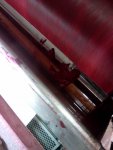We run a Goss Community 8 floor units and 4 deck units to give us 8 pgs of full color back to back. We use water socks with Red One water socks. We have used a neutral fountain solution and are trying a mild acid now. Color ink is US ink High strength. A one way water water system from ENHANCED OFFSET SYSTEMS, was installed years ago and the tanks were scrapped. This has worked well IF you keep the ink out of the pans. As the web width has narrowed over the years 27 1/2" to 23" I grown to dislike water stops. The problem is our current boss isn't allowing any modification to water stops. As you can see in the photos they fill with ink and then the ink floats in the pan up to the chrome pick-up and acts like another water stop and causes scumming at random areas on printed products.
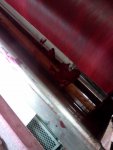
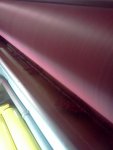
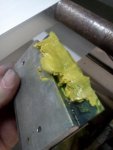
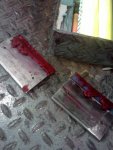
Water stop photos where taken after one run of 14,000 copies.
The ends of the socks become so packed with ink they don't pick up water and when we switch to 32" paper we have to clean the socks with brushes and squirt bottles. All the ink and crap fall into the pans out of the socks and the water and pans get filthy.
I briefly got to run the press without water stops and the socks lasted much longer as we weren't scrubbing them with brushes, the water was cleaner because the ink wasn't flowing into the pan, you could run the plates drier, no ink was on the water form roller and no ink was packing into the socks. Even got it to not throw water off the plates if you watched the ramp while running.
VID_20110610_011221.mp4 Video by jeep_man_401 | Photobucket
We have a CTP and could put banding in the sides of the plates off the web to try and control water on the ends of the plates that way but not sure if that would help either. Instead of going back to the tanks spending money to buy new tank system in order to remove the ink that is now being put into the water pans by the water stops. We will go threw more socks, more ink, more water and more spoils and more web breaks from wetter plates.
The ends of the plates are covered in ink now (because the water stops) while running and water form roller gets covered in ink as well. Ends of transfer rollers and form rollers are now running dry because the ink is gone and apparently going straight into the water stops and water.
What are some opinions on running wetter plates vs dries plates? Anyone use the one way water system? Photos of your water stops would be nice.




Water stop photos where taken after one run of 14,000 copies.
The ends of the socks become so packed with ink they don't pick up water and when we switch to 32" paper we have to clean the socks with brushes and squirt bottles. All the ink and crap fall into the pans out of the socks and the water and pans get filthy.
I briefly got to run the press without water stops and the socks lasted much longer as we weren't scrubbing them with brushes, the water was cleaner because the ink wasn't flowing into the pan, you could run the plates drier, no ink was on the water form roller and no ink was packing into the socks. Even got it to not throw water off the plates if you watched the ramp while running.
VID_20110610_011221.mp4 Video by jeep_man_401 | Photobucket
We have a CTP and could put banding in the sides of the plates off the web to try and control water on the ends of the plates that way but not sure if that would help either. Instead of going back to the tanks spending money to buy new tank system in order to remove the ink that is now being put into the water pans by the water stops. We will go threw more socks, more ink, more water and more spoils and more web breaks from wetter plates.
The ends of the plates are covered in ink now (because the water stops) while running and water form roller gets covered in ink as well. Ends of transfer rollers and form rollers are now running dry because the ink is gone and apparently going straight into the water stops and water.
What are some opinions on running wetter plates vs dries plates? Anyone use the one way water system? Photos of your water stops would be nice.
Attachments
Last edited:




